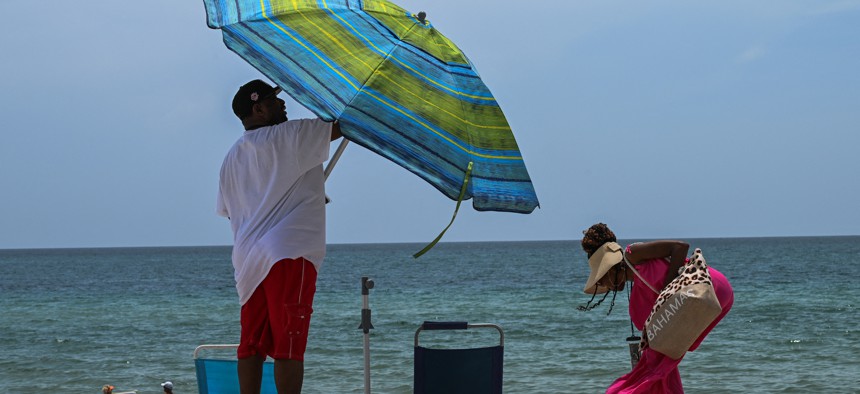Policy
Miami-Dade gets aggressive about dealing with heat
The South Florida county declared its first ever heat emergency this past weekend as it swelters under three-digit temperatures.

Beachgoers during an intense heat wave in Miami Beach on July 16, 2023. The National Weather Service warned of an "extremely hot and dangerous weekend," with daytime highs reaching up to 116 Fahrenheit (47 celsius). Photo by GIORGIO VIERA/AFP via Getty Images
As Miami-Dade County – which declared its first ever heat emergency this past weekend – swelters under three-digit temperatures, its elected officials legislated some relief for outdoor workers.
Miami-Dade Commissioners Marleine Bastien and Kionne McGhee, a former Florida House Democratic leader, co-sponsored an heat ordinance that passed on first reading.
On a day when the heat index is 90° F or more, workers would be required to have a ten-minute break in the shade and water breaks every two hours. A new county Office of Workplace Health and Safety also would be created.
Previous coverage –
- Stay cool: Miami-Dade announces ‘heat season’
- Can Jane Gilbert beat the heat and save lives in South Florida?
- More trees, cooler pavements: Miami-Dade tries tackling its extreme heat problem
Known as the “Que Calor” (“So Hot”) Ordinance, it was originally requested by WeCount, a group that represent outdoor workers. Its aim is to educate people who work outdoors and those who supervise them about the health problems associated with heat.
Miami-Dade County Chief Heat Officer Jane Gilbert said Miami has a “heat season” that runs May 1-Oct. 31.
“We are running public service advisories to educate the public about heat. They are being sent in English, Spanish and Creole through outdoor media and social media,” she said.
“We want people to be vigilant about heat. We are establishing educational programs with community partners to train people about how to deal with excessive heat. And we are working to retrofit buildings and homes so they are cooler.”
Another goal is increasing the tree canopy by 30%, for which the county has committed $2.5 million for more trees. It’s seeking $26 million in grants to plant more trees.
“Extreme heat is one of the most dangerous consequences of climate change that directly affects our most vulnerable population,” Miami-Dade Mayor Daniella Levine Cava said in a statement.
“If we combine all climate-related deaths, heat takes the largest toll, and most of those dying are from our most vulnerable and low-income communities.”
David Volz has been a reporter for numerous community news publications throughout South Florida over the past two decades, as well as the South Florida Sun-Sentinel, Miami Herald and South Florida Business Journal. He covers local government, schools, sports, culture, faith groups and workplaces.
NEXT STORY: Federal appeals court weighs Florida lawmaker subpoenas